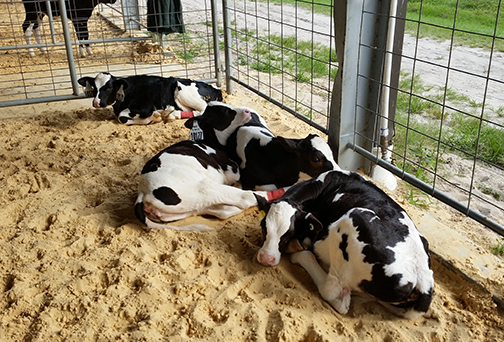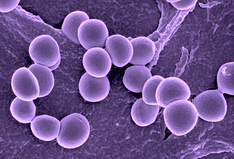|
Having trouble viewing this email? View it as a Web page.

|
|
|
Editor: Kelly Sprute June 19, 2019
Making a Difference
 NIFA funds research into early dairy cattle development at the UF Dairy Unit in Hague, north of Gainesville, Florida. Photo courtesy of UF/IFAS.
Growing Up with a Friend May Improve a Dairy Cow’s Welfare
If young dairy calves live together, they develop better social skills and may eventually produce more milk as a cow, a University of Florida (UF) scientist says. Just like humans, dairy cows need to adapt to changing environments as they develop. That includes moving among social groups, changing housing arrangements and entering the milking parlor, said Emily Miller-Cushon, an assistant professor of animal sciences at the UF Institute of Food and Agricultural Sciences (UF/IFAS).
A cow’s ability to cope with these events depends on her ability to learn and interact socially with other cows, said Miller-Cushon. The more adaptable they are, the less stress and fear they will feel in new situations and the more milk they should produce, the UF/IFAS scientist said. This means that their welfare, which broadly refers to the animal’s health and performance, emotional state, and opportunity for normal behaviors like socialization, will improve. Read the full University of Florida blog.
Miller-Cushon will use a new $490,000 grant from NIFA to fund research into early dairy cattle development.
|
|

Online Hands-On Mapping System Helps Keep Pollinators Safe
Researchers have been working for well over a decade to enhance the health of pollinators and now beekeepers, citizen scientists, and anyone interested in pollinator health can join in using a new online tool, Beescape. A multi-institutional research team led by Penn State University developed Beescape to help beekeepers understand what resources and risks bees may encounter when they leave the hive. The team includes Dickinson College, Purdue University, University of Illinois at Urbana-Champaign, University of Wisconsin, University of Minnesota, University of California – Davis, and USDA’s Agricultural Research Service. USDA’s National Institute of Food and Agriculture provided funding for this project. Read the full USDA blog.
Bees are responsible for pollinating approximately $15 billion worth of crops in the United States each year. Photo courtesy of USDA Forest Service.
|

Research Aims to Prevent Resistance to Staph Infection Treatment
Researchers at the University of Nebraska–Lincoln (UNL) are working to halt resistance to an antibiotic used to treat serious staph infections in humans. Staphylococcus aureus is a bacterium commonly found on the skin or noses of people and animals, even healthy ones. While this bacterium is a common cause of skin infections, it can invade other areas of the body and cause life-threatening infections. In fact, this bacterium causes more deaths in the United States than does HIV/AIDS. Read the full UNL news article.
Staphylococcus aureus is a versatile bacterium that is commonly found on the skin or noses of people and animals. Photo courtesy of University of Nebraska-Lincoln.
|
NIFA Invests $6.7 Million to Improve Sustainable Agricultural Productivity
NIFA recently awarded nine Agricultural Microbiomes in Plant Systems and Natural Resources grants part of the Agriculture and Food Research Initiative - Foundational and Applied Science priority area. This program focus on understanding the multipartite interactions among the host, environment, and the microbiome; thereby providing information critical for improving and sustaining agricultural productivity. Research will help fill major knowledge gaps in characterizing agricultural microbiomes and microbiome functions across agricultural production systems and natural resources.
NIFA Invest In Conserving Natural Resources in Rural Communities
NIFA recently awarded two Agriculture Economics and Rural Communities (AERC) grants. The AERC program is a collaboration with USDA's Natural Resource Conservation Service to enhance our understanding of the roles ecosystem services or conservation practices play in protecting our natural resource. AERC program promotes economically, socially, and environmentally sustainable agriculture and resilient rural communities through economic and social science research that informs decision making, policy design, and implementation of sustainable agricultural production systems and natural resource practices. These grants are part of NIFA’s Agricultural and Food Research Initiative.
NIFA Invests $1.5 Million in Agricultural Economics and Rural Communities
NIFA recently awarded three Economic Implications and Applications of Big Data in Food and Agriculture grants. This program is a priority area for the Agriculture Economics and Rural Communities program and is a collaboration between NIFA and USDA's Economic Research Service. The Economic Implications and Applications of Big Data in Food and Agriculture program addresses how big data influences markets, industry structure, and agricultural and food value chains through training agricultural economists in the use of data science to address the value of big data to U.S. farmers. These grants are part of NIFA’s Agricultural and Food Research Initiative.
CYFAR 4-H Military Partnership Professional Development and Technical Assistance
The CYFAR 4-H Military Partnership Professional Development and Technical Assistance (CMPC-PDTA) program supports the implementation and capacity of the 4-H Military Partnership and Outreach Support Program. Professional development and technical assistance are provided to the land-grant institutions and Cooperative Extension System, so that, in collaboration with other organizations, they are able to develop and deliver educational programs for military-connected youth. Read the full CMPC-PDTA request for applications.
|
|
|
NIFA’s mission is to invest in and advance agricultural
research, education, and extension that solve societal challenges. NIFA’s
investments in transformative science directly support the long-term prosperity
and global preeminence of U.S. agriculture. Keep informed about NIFA, USDA,
our land-grant and non-land-grant universities, and stakeholders with the NIFA
Update. Read past issues online,
sign up for email
updates or follow us on Twitter @USDA_NIFA, #NIFAImpacts.
If you wish to submit a news item or information, send an
email to NIFAUpdate.
USDA is an equal opportunity lender, provider, and
employer.
|
|